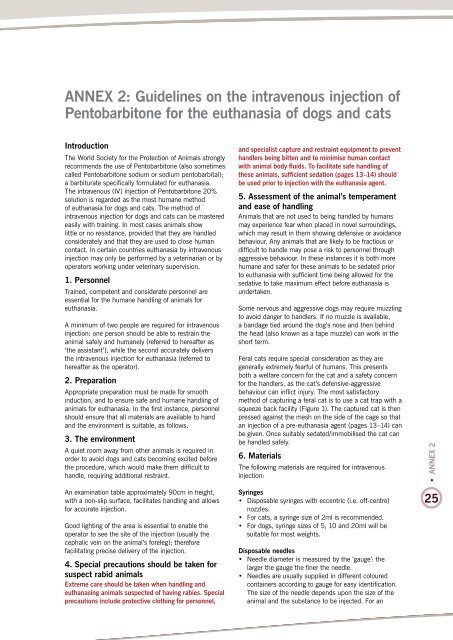Methods for the euthanasia of dogs and cats - Canine Rabies ...
Methods for the euthanasia of dogs and cats - Canine Rabies ...
Methods for the euthanasia of dogs and cats - Canine Rabies ...
You also want an ePaper? Increase the reach of your titles
YUMPU automatically turns print PDFs into web optimized ePapers that Google loves.
ANNEX 2: Guidelines on <strong>the</strong> intravenous injection <strong>of</strong><br />
Pentobarbitone <strong>for</strong> <strong>the</strong> <strong>euthanasia</strong> <strong>of</strong> <strong>dogs</strong> <strong>and</strong> <strong>cats</strong><br />
Introduction<br />
The World Society <strong>for</strong> <strong>the</strong> Protection <strong>of</strong> Animals strongly<br />
recommends <strong>the</strong> use <strong>of</strong> Pentobarbitone (also sometimes<br />
called Pentobarbitone sodium or sodium pentobarbital);<br />
a barbiturate specifically <strong>for</strong>mulated <strong>for</strong> <strong>euthanasia</strong>.<br />
The intravenous (IV) injection <strong>of</strong> Pentobarbitone 20%<br />
solution is regarded as <strong>the</strong> most humane method<br />
<strong>of</strong> <strong>euthanasia</strong> <strong>for</strong> <strong>dogs</strong> <strong>and</strong> <strong>cats</strong>. The method <strong>of</strong><br />
intravenous injection <strong>for</strong> <strong>dogs</strong> <strong>and</strong> <strong>cats</strong> can be mastered<br />
easily with training. In most cases animals show<br />
little or no resistance, provided that <strong>the</strong>y are h<strong>and</strong>led<br />
considerately <strong>and</strong> that <strong>the</strong>y are used to close human<br />
contact. In certain countries <strong>euthanasia</strong> by intravenous<br />
injection may only be per<strong>for</strong>med by a veterinarian or by<br />
operators working under veterinary supervision.<br />
1. Personnel<br />
Trained, competent <strong>and</strong> considerate personnel are<br />
essential <strong>for</strong> <strong>the</strong> humane h<strong>and</strong>ling <strong>of</strong> animals <strong>for</strong><br />
<strong>euthanasia</strong>.<br />
A minimum <strong>of</strong> two people are required <strong>for</strong> intravenous<br />
injection: one person should be able to restrain <strong>the</strong><br />
animal safely <strong>and</strong> humanely (referred to hereafter as<br />
‘<strong>the</strong> assistant’), while <strong>the</strong> second accurately delivers<br />
<strong>the</strong> intravenous injection <strong>for</strong> <strong>euthanasia</strong> (referred to<br />
hereafter as <strong>the</strong> operator).<br />
2. Preparation<br />
Appropriate preparation must be made <strong>for</strong> smooth<br />
induction, <strong>and</strong> to ensure safe <strong>and</strong> humane h<strong>and</strong>ling <strong>of</strong><br />
animals <strong>for</strong> <strong>euthanasia</strong>. In <strong>the</strong> first instance, personnel<br />
should ensure that all materials are available to h<strong>and</strong><br />
<strong>and</strong> <strong>the</strong> environment is suitable, as follows.<br />
3. The environment<br />
A quiet room away from o<strong>the</strong>r animals is required in<br />
order to avoid <strong>dogs</strong> <strong>and</strong> <strong>cats</strong> becoming excited be<strong>for</strong>e<br />
<strong>the</strong> procedure, which would make <strong>the</strong>m difficult to<br />
h<strong>and</strong>le, requiring additional restraint.<br />
An examination table approximately 90cm in height,<br />
with a non-slip surface, facilitates h<strong>and</strong>ling <strong>and</strong> allows<br />
<strong>for</strong> accurate injection.<br />
Good lighting <strong>of</strong> <strong>the</strong> area is essential to enable <strong>the</strong><br />
operator to see <strong>the</strong> site <strong>of</strong> <strong>the</strong> injection (usually <strong>the</strong><br />
cephalic vein on <strong>the</strong> animal’s <strong>for</strong>eleg); <strong>the</strong>re<strong>for</strong>e<br />
facilitating precise delivery <strong>of</strong> <strong>the</strong> injection.<br />
4. Special precautions should be taken <strong>for</strong><br />
suspect rabid animals<br />
Extreme care should be taken when h<strong>and</strong>ling <strong>and</strong><br />
euthanasing animals suspected <strong>of</strong> having rabies. Special<br />
precautions include protective clothing <strong>for</strong> personnel,<br />
<strong>and</strong> specialist capture <strong>and</strong> restraint equipment to prevent<br />
h<strong>and</strong>lers being bitten <strong>and</strong> to minimise human contact<br />
with animal body fluids. To facilitate safe h<strong>and</strong>ling <strong>of</strong><br />
<strong>the</strong>se animals, sufficient sedation (pages 13–14) should<br />
be used prior to injection with <strong>the</strong> <strong>euthanasia</strong> agent.<br />
5. Assessment <strong>of</strong> <strong>the</strong> animal’s temperament<br />
<strong>and</strong> ease <strong>of</strong> h<strong>and</strong>ling<br />
Animals that are not used to being h<strong>and</strong>led by humans<br />
may experience fear when placed in novel surroundings,<br />
which may result in <strong>the</strong>m showing defensive or avoidance<br />
behaviour. Any animals that are likely to be fractious or<br />
difficult to h<strong>and</strong>le may pose a risk to personnel through<br />
aggressive behaviour. In <strong>the</strong>se instances it is both more<br />
humane <strong>and</strong> safer <strong>for</strong> <strong>the</strong>se animals to be sedated prior<br />
to <strong>euthanasia</strong> with sufficient time being allowed <strong>for</strong> <strong>the</strong><br />
sedative to take maximum effect be<strong>for</strong>e <strong>euthanasia</strong> is<br />
undertaken.<br />
Some nervous <strong>and</strong> aggressive <strong>dogs</strong> may require muzzling<br />
to avoid danger to h<strong>and</strong>lers. If no muzzle is available,<br />
a b<strong>and</strong>age tied around <strong>the</strong> dog’s nose <strong>and</strong> <strong>the</strong>n behind<br />
<strong>the</strong> head (also known as a tape muzzle) can work in <strong>the</strong><br />
short term.<br />
Feral <strong>cats</strong> require special consideration as <strong>the</strong>y are<br />
generally extremely fearful <strong>of</strong> humans. This presents<br />
both a welfare concern <strong>for</strong> <strong>the</strong> cat <strong>and</strong> a safety concern<br />
<strong>for</strong> <strong>the</strong> h<strong>and</strong>lers, as <strong>the</strong> cat’s defensive-aggressive<br />
behaviour can inflict injury. The most satisfactory<br />
method <strong>of</strong> capturing a feral cat is to use a cat trap with a<br />
squeeze back facility (Figure 1). The captured cat is <strong>the</strong>n<br />
pressed against <strong>the</strong> mesh on <strong>the</strong> side <strong>of</strong> <strong>the</strong> cage so that<br />
an injection <strong>of</strong> a pre-<strong>euthanasia</strong> agent (pages 13–14) can<br />
be given. Once suitably sedated/immobilised <strong>the</strong> cat can<br />
be h<strong>and</strong>led safely.<br />
6. Materials<br />
The following materials are required <strong>for</strong> intravenous<br />
injection:<br />
Syringes<br />
• Disposable syringes with eccentric (i.e. <strong>of</strong>f-centre)<br />
nozzles.<br />
• For <strong>cats</strong>, a syringe size <strong>of</strong> 2ml is recommended.<br />
• For <strong>dogs</strong>, syringe sizes <strong>of</strong> 5, 10 <strong>and</strong> 20ml will be<br />
suitable <strong>for</strong> most weights.<br />
Disposable needles<br />
• Needle diameter is measured by <strong>the</strong> ‘gauge’: <strong>the</strong><br />
larger <strong>the</strong> gauge <strong>the</strong> finer <strong>the</strong> needle.<br />
• Needles are usually supplied in different coloured<br />
containers according to gauge <strong>for</strong> easy identification.<br />
The size <strong>of</strong> <strong>the</strong> needle depends upon <strong>the</strong> size <strong>of</strong> <strong>the</strong><br />
animal <strong>and</strong> <strong>the</strong> substance to be injected. For an<br />
• ANNEX 2<br />
25


